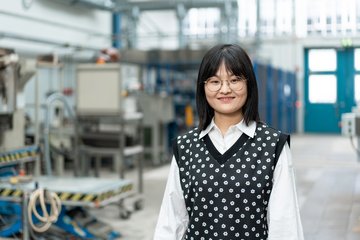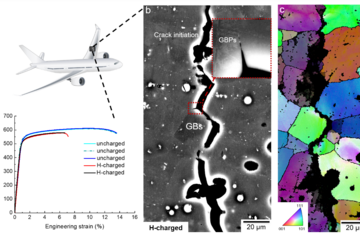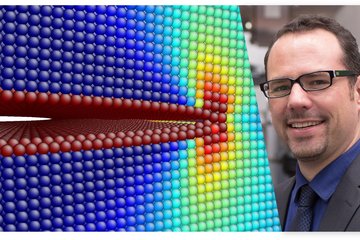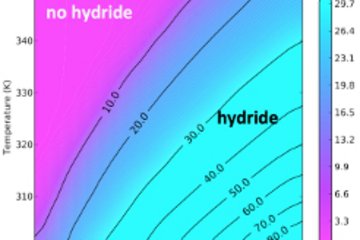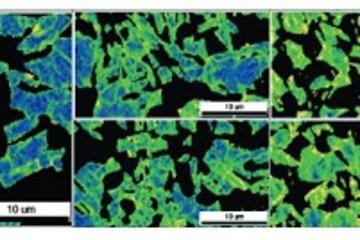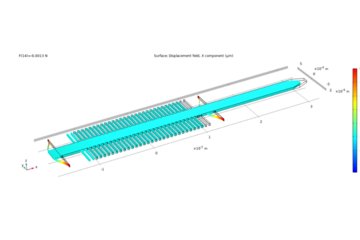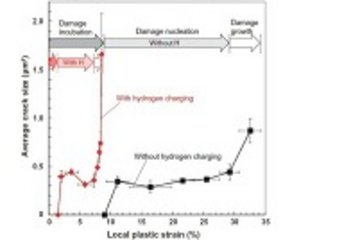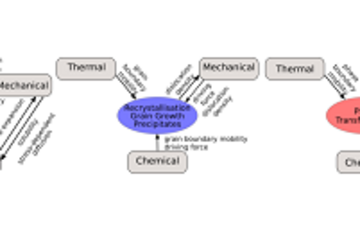Selective oxidation of alloying elements on surfaces and at grain boundaries
Selective oxidation plays a crucial role in many high temperature processes applied in industrial production technology. One example is recrystallization annealing, which is an important step for adjusting the mechanical properties of steel. Hot dip galvanising, which is done right after the annealing process, is significantly affected by correlated selective oxidation on the surface. Our research on the reactive wetting behaviour of liquid zinc on a variety of steels and model alloys has provided new insight into the wetting kinetics and how it depends on the oxide morphology resulting from this recrystallization annealing. At the focus in the last years were co-segregation effects of alloying elements in surface oxide formation [1-3] and effects of oxygen partial pressure not only on the wetting properties of liquid zinc but also on the subsurface structure and its mechanical properties [3-5]. A big success was the development of a novel thermo-balance set-up, where the reaction gas atmosphere is adjusted without carrier gas and thus works under sub-atmospheric pressures but with the same dew points and hydrogen partial pressures as applied in standard experiments. That allows measurements even during fast heating and cooling steps, such as, e.g., during recrystallization annealing before hot dipping, without buoyancy forces and with nearly no disturbances at all [6, 7]
This method plays also an important role for the investigation of grain boundary oxide growth during cooling of steel sheet after hot rolling [6, 8]. Very important results for a better understanding of oxidation during short term annealing were obtained with the Christian-Doppler Laboratory for Diffusion and segregation mechanisms during production of high strength steel sheet headed by M. Rohwerder from 2008-2014. More details will be shown here soon.
1.
Swaminathan, S.; Rohwerder, M.: Role of Forming Gas Annealing Characteristics on the Selective Surface Oxidation of Fe–Mn–Si–Cr Model Alloy. 6th International Conference on Diffusion in Solids and Liquids, DSL-2010, Paris, France, July 05, 2010 - July 07, 2010. Defect and Diffusion Forum 312-315, pp. 918 - 923 (2011)
2.
Swaminathan, S.; Rohwerder, M.; Rohwerder, M.; Spiegel, M.: Temperature and dew point dependent segregation of phosphorus and sulfur in Fe–Mn–P–S model alloy. Surface and Coatings Technology 205 (16), pp. 4089 - 4093 (2011)
3.
Prabhudev, S.; Swaminathan, S.; Rohwerder, M.: Effect of oxides on the reaction kinetics during hot-dip galvanizing of high strength steels. Corrosion Science 53 (7), pp. 2413 - 2418 (2011)
4.
Liu, H.; He, Y.; Swaminathan, S.; Rohwerder, M.; Li, L.: Effect of dew point on the surface selective oxidation and subsurface microstructure of TRIP-aided steel. Surface and Coatings Technology 206 (6), pp. 1237 - 1243 (2011)
5.
Liu, H.; Li, F.; Shi, W.; Swaminathan, S.; He, Y.; Rohwerder, M.; Li, L.: Challenges in hot-dip galvanizing of high strength dual phase steel: Surface selective oxidation and mechanical property degradation. Surface and Coatings Technology 206 (16), pp. 3428 - 3436 (2012)
6.
Auinger, M.; Vogel, A.; Vogel, D.; Rohwerder, M.: Early stages of oxidation observed by in situ thermogravimetry in low pressure atmospheres. Corrosion Science 86, pp. 183 - 188 (2014)
7.
Auinger, M.; Vogel, D.; Vogel, A.; Spiegel, M.; Rohwerder, M.: A novel laboratory set-up for investigating surface and interface reactions during short term annealing cycles at high temperatures. Review of Scientific Instruments 84, 085108 (2013)
8.
Auinger, M.; Vogel, A.; Praig, V. G.; Danninger, H.; Rohwerder, M.: Thermogravimetry and insitu mass spectrometry at high temperatures compared to theoretical modelling - The weight loss during selective decarburisation at 800 °C. Corrosion Science 78, pp. 188 - 192 (2014)

